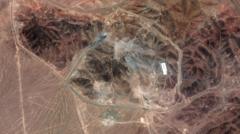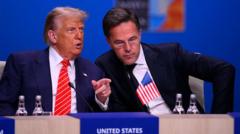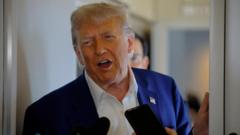In a decisive election, Canadians are choosing their next leader against the backdrop of President Trump’s trade tensions, with both major parties presenting differing solutions to national challenges.
**Canada Faces a Pivotal Election: Voter Sentiment Swings Amidst Global Tensions**

**Canada Faces a Pivotal Election: Voter Sentiment Swings Amidst Global Tensions**
As Canadians cast their votes, the balance of power in the country hangs in the balance with rising support for the Liberal Party as they confront external pressures.
On April 28, 2025, Canadians are casting their ballots in a consequential election to determine the future leadership of the nation. The race pits the Liberal Party, led by Prime Minister Mark Carney, against the Conservative Party and its leader, Pierre Poilievre, amid a rapidly shifting political landscape exacerbated by President Trump's trade disputes and calls to threaten Canada’s sovereignty.
Just months ago, the Conservative Party held a significant lead in the polls, with Pierre Poilievre poised for victory. However, following Prime Minister Justin Trudeau's resignation and the increased scrutiny on Trump’s trade policies, support for the Liberal Party has surged. Pre-election surveys indicated a narrow edge for the Liberals, with Canadian voters poised to influence the nation’s response to external pressures.
In total, five political parties are vying for parliamentary seats, including the New Democratic Party, the Green Party, and Bloc Quebecois, all projected to secure minimal representation. The dominant narrative of the election centers around how the next government will handle Trump’s tariffs, which have destabilized key sectors of Canada's economy.
Both Carney and Poilievre embody contrasting visions for Canada's leadership, each presenting unique experiences and strategies. Carney, a seasoned banker, seeks to capitalize on his financial acumen to shield Canada from Trump's aggressive policies, while Poilievre champions a return to smaller government and reduced regulation, echoing Trump's populist themes.
Voter turnout appears strong, with early reports suggesting that approximately 7 million Canadians have already participated before Election Day. Polls opened across the country's various time zones, with capital cities expected to close by 9:30 p.m. ET.
As results begin to roll in late Monday night, the early projections show close contests in key provinces, particularly Ontario and Quebec, which are critical for party representation. Canadian elections typically feature candidates vying for their local riding, with the party winning the most seats ultimately forming the government, even without an outright majority.
In this climate, speculation rises about how Trump’s tariffs and sovereignty threats will shape response strategies from both candidates. With voters prioritizing economic management and international relations, the implications of this election could resonate beyond Canada’s borders.
Polling suggests that many Canadians are looking for a strong voice against Trump's aggressive policies, and with the results on the horizon, the political landscape of Canada may be irrevocably altered.
The electoral outcome will not only redefine Canada’s internal leadership but also dictate how the country navigates a challenging international stage. Voter engagement remains high as citizens respond to a compelling narrative interwoven with the overarching theme of national identity in the face of foreign pressures.
Just months ago, the Conservative Party held a significant lead in the polls, with Pierre Poilievre poised for victory. However, following Prime Minister Justin Trudeau's resignation and the increased scrutiny on Trump’s trade policies, support for the Liberal Party has surged. Pre-election surveys indicated a narrow edge for the Liberals, with Canadian voters poised to influence the nation’s response to external pressures.
In total, five political parties are vying for parliamentary seats, including the New Democratic Party, the Green Party, and Bloc Quebecois, all projected to secure minimal representation. The dominant narrative of the election centers around how the next government will handle Trump’s tariffs, which have destabilized key sectors of Canada's economy.
Both Carney and Poilievre embody contrasting visions for Canada's leadership, each presenting unique experiences and strategies. Carney, a seasoned banker, seeks to capitalize on his financial acumen to shield Canada from Trump's aggressive policies, while Poilievre champions a return to smaller government and reduced regulation, echoing Trump's populist themes.
Voter turnout appears strong, with early reports suggesting that approximately 7 million Canadians have already participated before Election Day. Polls opened across the country's various time zones, with capital cities expected to close by 9:30 p.m. ET.
As results begin to roll in late Monday night, the early projections show close contests in key provinces, particularly Ontario and Quebec, which are critical for party representation. Canadian elections typically feature candidates vying for their local riding, with the party winning the most seats ultimately forming the government, even without an outright majority.
In this climate, speculation rises about how Trump’s tariffs and sovereignty threats will shape response strategies from both candidates. With voters prioritizing economic management and international relations, the implications of this election could resonate beyond Canada’s borders.
Polling suggests that many Canadians are looking for a strong voice against Trump's aggressive policies, and with the results on the horizon, the political landscape of Canada may be irrevocably altered.
The electoral outcome will not only redefine Canada’s internal leadership but also dictate how the country navigates a challenging international stage. Voter engagement remains high as citizens respond to a compelling narrative interwoven with the overarching theme of national identity in the face of foreign pressures.























